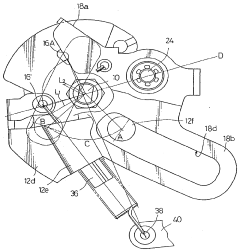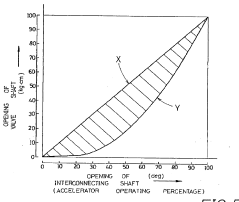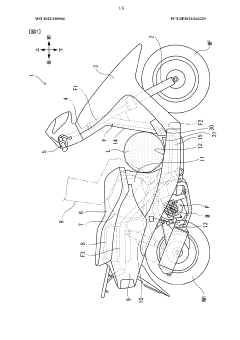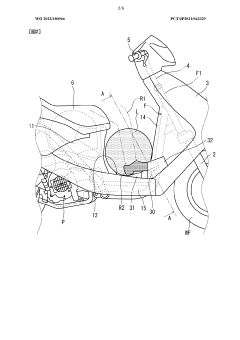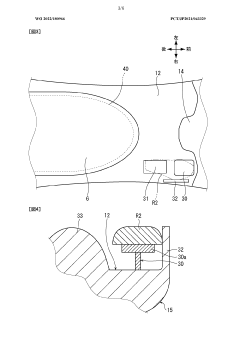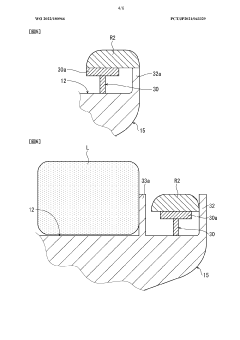Exploring Throttle Body Control in Rock Crawling Scenarios
JUL 18, 20259 MIN READ
Generate Your Research Report Instantly with AI Agent
Patsnap Eureka helps you evaluate technical feasibility & market potential.
Rock Crawling Throttle Control Evolution
The evolution of throttle body control in rock crawling scenarios has undergone significant advancements over the years, reflecting the growing demands of off-road enthusiasts and the technological progress in automotive engineering. Initially, rock crawling vehicles relied on simple mechanical throttle linkages, which provided limited control and responsiveness in challenging terrain.
As the sport gained popularity in the 1990s, the need for more precise throttle control became apparent. This led to the introduction of cable-operated throttle bodies, which offered improved modulation and sensitivity. However, these systems still had limitations in terms of fine-tuning and adaptability to different driving conditions.
The early 2000s saw a major shift with the advent of electronic throttle control (ETC) systems, also known as drive-by-wire technology. This innovation replaced mechanical linkages with electronic sensors and actuators, allowing for more precise control of engine power delivery. ETC systems enabled rock crawlers to navigate obstacles with greater finesse, as drivers could now make minute adjustments to throttle input.
Further refinements in ETC technology brought about adaptive throttle mapping, which allowed drivers to select different throttle response profiles based on terrain conditions. This feature proved particularly valuable in rock crawling, where the ability to switch between aggressive and conservative throttle responses could make the difference in conquering difficult obstacles.
The integration of traction control systems with throttle management marked another significant milestone. These systems could automatically modulate throttle input based on wheel slip, helping to maintain optimal traction in loose or slippery conditions often encountered in rock crawling.
Recent years have seen the incorporation of artificial intelligence and machine learning algorithms into throttle control systems. These advanced technologies can analyze various parameters such as vehicle angle, wheel speed, and surface conditions in real-time, automatically adjusting throttle response for optimal performance and safety.
The latest developments in rock crawling throttle control focus on seamless integration with other vehicle systems. Modern throttle bodies now communicate with transmission control units, suspension systems, and differential locks to provide a holistic approach to vehicle control in extreme off-road situations. This level of integration allows for unprecedented levels of vehicle stability and maneuverability in rock crawling scenarios.
Looking ahead, the future of throttle control in rock crawling is likely to involve even more sophisticated sensor technologies and predictive algorithms. These advancements will further enhance the symbiosis between driver input and vehicle response, potentially leading to semi-autonomous rock crawling capabilities that can assist drivers in navigating the most challenging terrains.
As the sport gained popularity in the 1990s, the need for more precise throttle control became apparent. This led to the introduction of cable-operated throttle bodies, which offered improved modulation and sensitivity. However, these systems still had limitations in terms of fine-tuning and adaptability to different driving conditions.
The early 2000s saw a major shift with the advent of electronic throttle control (ETC) systems, also known as drive-by-wire technology. This innovation replaced mechanical linkages with electronic sensors and actuators, allowing for more precise control of engine power delivery. ETC systems enabled rock crawlers to navigate obstacles with greater finesse, as drivers could now make minute adjustments to throttle input.
Further refinements in ETC technology brought about adaptive throttle mapping, which allowed drivers to select different throttle response profiles based on terrain conditions. This feature proved particularly valuable in rock crawling, where the ability to switch between aggressive and conservative throttle responses could make the difference in conquering difficult obstacles.
The integration of traction control systems with throttle management marked another significant milestone. These systems could automatically modulate throttle input based on wheel slip, helping to maintain optimal traction in loose or slippery conditions often encountered in rock crawling.
Recent years have seen the incorporation of artificial intelligence and machine learning algorithms into throttle control systems. These advanced technologies can analyze various parameters such as vehicle angle, wheel speed, and surface conditions in real-time, automatically adjusting throttle response for optimal performance and safety.
The latest developments in rock crawling throttle control focus on seamless integration with other vehicle systems. Modern throttle bodies now communicate with transmission control units, suspension systems, and differential locks to provide a holistic approach to vehicle control in extreme off-road situations. This level of integration allows for unprecedented levels of vehicle stability and maneuverability in rock crawling scenarios.
Looking ahead, the future of throttle control in rock crawling is likely to involve even more sophisticated sensor technologies and predictive algorithms. These advancements will further enhance the symbiosis between driver input and vehicle response, potentially leading to semi-autonomous rock crawling capabilities that can assist drivers in navigating the most challenging terrains.
Market Analysis for Off-Road Vehicle Technologies
The off-road vehicle market has been experiencing significant growth in recent years, driven by increasing interest in outdoor recreation and adventure sports. Rock crawling, a specialized form of off-road driving that involves navigating extremely rough terrain, has emerged as a popular niche within this market. As a result, there is a growing demand for advanced technologies that can enhance vehicle performance and control in these challenging environments.
The global off-road vehicle market was valued at approximately $13.5 billion in 2020 and is projected to reach $19.6 billion by 2027, growing at a CAGR of 5.7% during the forecast period. Within this market, the rock crawling segment is expected to show particularly strong growth, driven by enthusiasts seeking more extreme off-road experiences.
Throttle body control technology plays a crucial role in rock crawling scenarios, as it directly impacts vehicle responsiveness and power delivery. Precise throttle control is essential for navigating obstacles and maintaining traction on steep inclines. The market for advanced throttle control systems specifically designed for rock crawling applications is relatively new but rapidly expanding.
Key market drivers for throttle body control technologies in rock crawling include:
1. Increasing popularity of rock crawling events and competitions
2. Growing demand for vehicles with enhanced off-road capabilities
3. Rising consumer expectations for precise vehicle control in extreme conditions
4. Advancements in electronic throttle control systems and sensors
The market for throttle body control technologies in rock crawling is characterized by a mix of established automotive suppliers and specialized off-road equipment manufacturers. Major players in this space include Bosch, Continental AG, Delphi Technologies, and AISIN SEIKI Co., Ltd., as well as niche companies focused on off-road performance parts.
Consumer demand is primarily driven by off-road enthusiasts and competitive rock crawlers who are willing to invest in high-performance components to gain an edge in challenging terrain. There is also a growing market for aftermarket throttle control systems that can be retrofitted to existing vehicles, allowing owners to upgrade their rock crawling capabilities without purchasing a new vehicle.
The market analysis indicates several key trends shaping the future of throttle body control in rock crawling:
1. Integration of artificial intelligence and machine learning algorithms to optimize throttle response based on terrain conditions
2. Development of advanced sensors and terrain recognition systems to enhance throttle control accuracy
3. Increased focus on durability and reliability to withstand extreme off-road conditions
4. Growing demand for customizable throttle mapping options to suit different driving styles and terrain types
As the rock crawling market continues to evolve, there is significant potential for innovation in throttle body control technologies. Companies that can develop solutions that offer precise control, durability, and adaptability to various terrain conditions are likely to gain a competitive advantage in this growing market segment.
The global off-road vehicle market was valued at approximately $13.5 billion in 2020 and is projected to reach $19.6 billion by 2027, growing at a CAGR of 5.7% during the forecast period. Within this market, the rock crawling segment is expected to show particularly strong growth, driven by enthusiasts seeking more extreme off-road experiences.
Throttle body control technology plays a crucial role in rock crawling scenarios, as it directly impacts vehicle responsiveness and power delivery. Precise throttle control is essential for navigating obstacles and maintaining traction on steep inclines. The market for advanced throttle control systems specifically designed for rock crawling applications is relatively new but rapidly expanding.
Key market drivers for throttle body control technologies in rock crawling include:
1. Increasing popularity of rock crawling events and competitions
2. Growing demand for vehicles with enhanced off-road capabilities
3. Rising consumer expectations for precise vehicle control in extreme conditions
4. Advancements in electronic throttle control systems and sensors
The market for throttle body control technologies in rock crawling is characterized by a mix of established automotive suppliers and specialized off-road equipment manufacturers. Major players in this space include Bosch, Continental AG, Delphi Technologies, and AISIN SEIKI Co., Ltd., as well as niche companies focused on off-road performance parts.
Consumer demand is primarily driven by off-road enthusiasts and competitive rock crawlers who are willing to invest in high-performance components to gain an edge in challenging terrain. There is also a growing market for aftermarket throttle control systems that can be retrofitted to existing vehicles, allowing owners to upgrade their rock crawling capabilities without purchasing a new vehicle.
The market analysis indicates several key trends shaping the future of throttle body control in rock crawling:
1. Integration of artificial intelligence and machine learning algorithms to optimize throttle response based on terrain conditions
2. Development of advanced sensors and terrain recognition systems to enhance throttle control accuracy
3. Increased focus on durability and reliability to withstand extreme off-road conditions
4. Growing demand for customizable throttle mapping options to suit different driving styles and terrain types
As the rock crawling market continues to evolve, there is significant potential for innovation in throttle body control technologies. Companies that can develop solutions that offer precise control, durability, and adaptability to various terrain conditions are likely to gain a competitive advantage in this growing market segment.
Current Throttle Control Challenges in Rock Crawling
Rock crawling, a challenging off-road driving technique, presents unique throttle control challenges that push the limits of traditional vehicle control systems. The current throttle control mechanisms in rock crawling scenarios face several significant hurdles, primarily due to the extreme and unpredictable nature of the terrain.
One of the main challenges is the need for precise and instantaneous throttle modulation. In rock crawling, drivers must navigate over large boulders, steep inclines, and loose surfaces, requiring constant adjustments to the throttle input. Conventional throttle-by-wire systems often lack the sensitivity and responsiveness needed for such fine control, leading to potential loss of traction or unwanted vehicle movement.
The inconsistent surface conditions in rock crawling environments further complicate throttle control. As vehicles transition between different types of terrain, from solid rock to loose gravel or wet surfaces, the required throttle input can change dramatically within seconds. Current throttle control systems struggle to adapt quickly enough to these rapid changes, potentially compromising vehicle stability and driver control.
Another significant challenge is maintaining consistent low-speed control. Rock crawling often involves extremely slow maneuvers, sometimes at speeds less than 1 mph. Many existing throttle control systems are not optimized for such low-speed operations, making it difficult for drivers to maintain steady, controlled progress over obstacles.
The issue of wheel slip detection and management also poses a considerable challenge in rock crawling scenarios. When a wheel loses traction and begins to spin, immediate throttle adjustment is crucial. However, current systems often lack the rapid detection and response capabilities needed to prevent loss of control or potential damage to the terrain.
Furthermore, the integration of throttle control with other vehicle systems, such as the transmission and differential locks, presents additional complexities. In rock crawling, these systems need to work in perfect harmony to maximize traction and control. Current throttle control systems often operate too independently, lacking the necessary level of integration for optimal performance in extreme off-road conditions.
The physical design of throttle bodies also faces challenges in rock crawling environments. Exposure to dust, water, and impacts can affect the reliability and performance of traditional throttle mechanisms. Developing robust, weatherproof throttle control systems that can withstand the harsh conditions of rock crawling terrains remains an ongoing challenge for manufacturers.
Lastly, the human factor in throttle control presents a unique challenge in rock crawling. The extreme nature of the activity requires drivers to have exceptional skill and experience. Current throttle control systems often do not provide adequate feedback or assistance to less experienced drivers, making rock crawling more challenging and potentially dangerous for newcomers to the sport.
One of the main challenges is the need for precise and instantaneous throttle modulation. In rock crawling, drivers must navigate over large boulders, steep inclines, and loose surfaces, requiring constant adjustments to the throttle input. Conventional throttle-by-wire systems often lack the sensitivity and responsiveness needed for such fine control, leading to potential loss of traction or unwanted vehicle movement.
The inconsistent surface conditions in rock crawling environments further complicate throttle control. As vehicles transition between different types of terrain, from solid rock to loose gravel or wet surfaces, the required throttle input can change dramatically within seconds. Current throttle control systems struggle to adapt quickly enough to these rapid changes, potentially compromising vehicle stability and driver control.
Another significant challenge is maintaining consistent low-speed control. Rock crawling often involves extremely slow maneuvers, sometimes at speeds less than 1 mph. Many existing throttle control systems are not optimized for such low-speed operations, making it difficult for drivers to maintain steady, controlled progress over obstacles.
The issue of wheel slip detection and management also poses a considerable challenge in rock crawling scenarios. When a wheel loses traction and begins to spin, immediate throttle adjustment is crucial. However, current systems often lack the rapid detection and response capabilities needed to prevent loss of control or potential damage to the terrain.
Furthermore, the integration of throttle control with other vehicle systems, such as the transmission and differential locks, presents additional complexities. In rock crawling, these systems need to work in perfect harmony to maximize traction and control. Current throttle control systems often operate too independently, lacking the necessary level of integration for optimal performance in extreme off-road conditions.
The physical design of throttle bodies also faces challenges in rock crawling environments. Exposure to dust, water, and impacts can affect the reliability and performance of traditional throttle mechanisms. Developing robust, weatherproof throttle control systems that can withstand the harsh conditions of rock crawling terrains remains an ongoing challenge for manufacturers.
Lastly, the human factor in throttle control presents a unique challenge in rock crawling. The extreme nature of the activity requires drivers to have exceptional skill and experience. Current throttle control systems often do not provide adequate feedback or assistance to less experienced drivers, making rock crawling more challenging and potentially dangerous for newcomers to the sport.
Existing Throttle Control Solutions for Rock Crawling
01 Electronic throttle control systems
Electronic throttle control systems are used to regulate the airflow into an engine's combustion chamber. These systems typically include sensors, actuators, and a control unit to manage the throttle position based on various inputs such as accelerator pedal position and engine operating conditions.- Electronic throttle control systems: Electronic throttle control systems are used to regulate the airflow into the engine by controlling the throttle body position. These systems typically include sensors, actuators, and control modules to precisely adjust the throttle opening based on various input signals and driving conditions.
- Throttle body position sensors: Throttle body position sensors are crucial components in throttle control systems. These sensors provide feedback on the current throttle position to the engine control unit, allowing for accurate adjustment and monitoring of the throttle opening.
- Throttle body actuators: Throttle body actuators are responsible for physically moving the throttle plate to control airflow. These actuators can be electric motors or other mechanisms that receive signals from the control unit to adjust the throttle position precisely and quickly.
- Throttle control algorithms and software: Advanced algorithms and software are employed in throttle control systems to process input signals, determine optimal throttle positions, and manage various operating modes. These control strategies aim to improve engine performance, fuel efficiency, and emissions control.
- Fail-safe mechanisms in throttle control: Fail-safe mechanisms are incorporated into throttle control systems to ensure safe operation in case of component failures or system malfunctions. These mechanisms may include redundant sensors, default positions, and emergency shutdown procedures to prevent unintended acceleration or loss of engine control.
02 Throttle body design and components
Throttle body design focuses on optimizing airflow and control precision. Key components include the throttle valve, housing, and associated sensors. Innovations in this area aim to improve response time, reduce friction, and enhance overall engine performance.Expand Specific Solutions03 Throttle position sensors and feedback mechanisms
Accurate throttle position sensing is crucial for precise control. Advanced sensors and feedback mechanisms are employed to monitor and adjust throttle position in real-time, ensuring optimal engine performance and fuel efficiency across various operating conditions.Expand Specific Solutions04 Integrated throttle control systems
Integrated throttle control systems combine multiple engine management functions into a single unit. These systems often incorporate throttle control with other engine parameters such as fuel injection and ignition timing to achieve better overall engine performance and emissions control.Expand Specific Solutions05 Fail-safe and diagnostic features in throttle control
Modern throttle control systems incorporate fail-safe mechanisms and diagnostic features to ensure safe operation in case of component failure. These may include redundant sensors, default modes, and self-diagnostic capabilities to detect and respond to potential issues in the throttle control system.Expand Specific Solutions
Key Players in Off-Road Vehicle Control Systems
The throttle body control technology in rock crawling scenarios is in an early development stage, with a growing but still niche market. The technology's maturity varies among key players, with automotive giants like Toyota, Ford, and Honda likely having more advanced systems due to their extensive R&D capabilities. Emerging companies such as BYD and Weichai Power are also making strides in this field. The market is characterized by a mix of established automotive manufacturers and specialized off-road vehicle producers like Polaris and Traxxas, each bringing unique expertise to throttle control solutions for extreme terrain navigation. As the demand for enhanced off-road performance increases, we can expect rapid advancements and increased competition in this specialized sector.
Toyota Motor Corp.
Technical Solution: Toyota has implemented a sophisticated Crawl Control system in their off-road vehicles, which includes advanced throttle body control for rock crawling scenarios. This system automatically modulates the throttle and brakes to maintain a constant, slow speed over rough terrain[1]. The driver can select from five low-speed settings, allowing for precise control in various rock crawling situations. Toyota's system also incorporates Multi-Terrain Select technology, which adjusts throttle sensitivity and traction control parameters based on the specific type of terrain[2]. For rock crawling, this means reduced throttle sensitivity to prevent wheel spin and maintain traction. The system uses input from multiple sensors, including wheel speed sensors and a gyroscopic sensor to detect vehicle tilt, to make real-time adjustments to throttle input[3]. Additionally, Toyota's A-TRAC (Active Traction Control) works in conjunction with the throttle control system to distribute power to the wheels with the most traction, further enhancing rock crawling capabilities.
Strengths: Highly automated system requiring minimal driver input, comprehensive integration with other off-road technologies. Weaknesses: May reduce the 'hands-on' experience desired by some off-road enthusiasts, potential for over-reliance on technology in extreme situations.
Ford Global Technologies LLC
Technical Solution: Ford has developed the Trail Control system, which includes advanced throttle body control specifically designed for off-road scenarios like rock crawling. This system acts as a low-speed cruise control for off-road use, managing acceleration and braking to maintain a set speed while traversing difficult terrain[1]. For rock crawling, the system allows speeds as low as 1 mph, providing precise control in challenging situations. Ford's throttle control technology incorporates a terrain management system that adjusts throttle mapping and sensitivity based on the selected drive mode[2]. In rock crawl mode, throttle response is significantly dampened to prevent wheel slip and allow for more precise control. The system also integrates with Ford's electronic locking differentials and can send torque independently to each wheel as needed[3]. Additionally, Ford has implemented a feature called 'one-pedal drive' in some models, which allows the driver to control both acceleration and deceleration using only the accelerator pedal, further simplifying control in rock crawling scenarios.
Strengths: Highly automated system with very low-speed capabilities, integrates well with other off-road technologies. Weaknesses: May require some adjustment for drivers used to traditional throttle control, potential for reduced driver engagement in extreme off-road situations.
Innovative Throttle Body Control Mechanisms
Throttle body having interconnecting lever for converting an operational amount of accelerator to an opening of throttle valve
PatentInactiveUS4945874A
Innovation
- Incorporating a tension spring to stabilize the throttle valve, using a spiral spring for consistent force, and an eccentric mounting member for cam follower adjustment, along with separating the interconnecting lever into two parts to decouple auto speed control from the accelerator pedal, ensuring smooth operation and fine adjustment capabilities.
Rocking vehicle
PatentWO2022180966A1
Innovation
- The rocking vehicle features a throttle pedal positioned closer to the footrest with upward protruding outer and inner convex portions, a low-floor footrest design, and a stepped footrest configuration, allowing for three-point foot support and improved balance, increased loading capacity, and easy dirt discharge.
Environmental Impact of Off-Road Technologies
The environmental impact of off-road technologies, particularly in rock crawling scenarios, is a critical consideration for both manufacturers and enthusiasts. Throttle body control systems, while primarily designed for performance enhancement, also play a significant role in mitigating environmental damage caused by off-road vehicles.
Rock crawling, by its nature, involves traversing challenging terrains that are often ecologically sensitive. The precise control offered by advanced throttle body systems can reduce unnecessary wheel spin and soil disturbance. This minimizes erosion and protects fragile vegetation in rocky and mountainous areas. By allowing drivers to apply power more judiciously, these systems help preserve the natural landscape and reduce the long-term impact of off-road activities on local ecosystems.
Furthermore, improved throttle control contributes to better fuel efficiency in rock crawling scenarios. The ability to maintain steady, low-speed progress without constant acceleration and deceleration reduces overall fuel consumption. This not only extends the range of off-road vehicles but also decreases their carbon footprint, aligning with broader environmental conservation efforts.
The development of electronic throttle control systems has also enabled the integration of eco-friendly driving modes. These modes can be specifically tailored for rock crawling, optimizing power delivery to minimize environmental impact while maintaining necessary performance. Such technologies encourage responsible off-road practices and promote sustainable enjoyment of natural landscapes.
However, it is important to note that while throttle body control systems can mitigate some environmental impacts, they do not eliminate them entirely. Off-road activities, even with advanced control systems, still pose risks to natural habitats. Therefore, the development of these technologies must be coupled with education and guidelines for responsible off-road use.
Manufacturers are increasingly focusing on developing throttle control systems that not only enhance performance but also incorporate features to protect the environment. This includes sensors that can detect terrain types and automatically adjust throttle response to minimize ground disturbance. Some systems are also being designed to work in conjunction with traction control and differential locking mechanisms to further reduce environmental impact during rock crawling.
As environmental regulations become more stringent, the role of throttle body control in off-road vehicles is likely to expand. Future developments may include integration with GPS and topographical data to preemptively adjust throttle settings based on upcoming terrain challenges. This proactive approach could further reduce the ecological footprint of rock crawling activities.
Rock crawling, by its nature, involves traversing challenging terrains that are often ecologically sensitive. The precise control offered by advanced throttle body systems can reduce unnecessary wheel spin and soil disturbance. This minimizes erosion and protects fragile vegetation in rocky and mountainous areas. By allowing drivers to apply power more judiciously, these systems help preserve the natural landscape and reduce the long-term impact of off-road activities on local ecosystems.
Furthermore, improved throttle control contributes to better fuel efficiency in rock crawling scenarios. The ability to maintain steady, low-speed progress without constant acceleration and deceleration reduces overall fuel consumption. This not only extends the range of off-road vehicles but also decreases their carbon footprint, aligning with broader environmental conservation efforts.
The development of electronic throttle control systems has also enabled the integration of eco-friendly driving modes. These modes can be specifically tailored for rock crawling, optimizing power delivery to minimize environmental impact while maintaining necessary performance. Such technologies encourage responsible off-road practices and promote sustainable enjoyment of natural landscapes.
However, it is important to note that while throttle body control systems can mitigate some environmental impacts, they do not eliminate them entirely. Off-road activities, even with advanced control systems, still pose risks to natural habitats. Therefore, the development of these technologies must be coupled with education and guidelines for responsible off-road use.
Manufacturers are increasingly focusing on developing throttle control systems that not only enhance performance but also incorporate features to protect the environment. This includes sensors that can detect terrain types and automatically adjust throttle response to minimize ground disturbance. Some systems are also being designed to work in conjunction with traction control and differential locking mechanisms to further reduce environmental impact during rock crawling.
As environmental regulations become more stringent, the role of throttle body control in off-road vehicles is likely to expand. Future developments may include integration with GPS and topographical data to preemptively adjust throttle settings based on upcoming terrain challenges. This proactive approach could further reduce the ecological footprint of rock crawling activities.
Safety Considerations in Extreme Off-Road Scenarios
Safety considerations in extreme off-road scenarios, particularly in rock crawling, are paramount due to the inherent risks associated with navigating challenging terrain. The throttle body control system plays a crucial role in ensuring the safety of both the vehicle and its occupants during these demanding situations.
One of the primary safety concerns in rock crawling is the potential for sudden, uncontrolled acceleration. This can lead to loss of traction, vehicle rollover, or collision with obstacles. Advanced throttle body control systems incorporate precise sensors and algorithms to modulate power delivery, preventing wheel spin and maintaining optimal traction. These systems often work in conjunction with traction control and stability control systems to provide a comprehensive safety net for the driver.
Another critical safety aspect is the prevention of stalling in precarious positions. Rock crawling often involves traversing steep inclines and descents, where a stalled engine could result in a dangerous loss of control. Sophisticated throttle body control systems can maintain a consistent, low-speed crawl, even on extreme gradients, by intelligently managing fuel delivery and engine RPM.
The integration of throttle body control with other vehicle systems is essential for maximizing safety in extreme off-road scenarios. For instance, coupling throttle control with the braking system allows for hill descent control, automatically modulating speed on steep declines without driver intervention. This reduces the risk of skidding or loss of control on treacherous downhill sections.
Environmental factors also play a significant role in safety considerations for throttle body control in rock crawling. Dust, mud, and water ingress can potentially interfere with sensor operation or electronic components. Therefore, robust design and sealing of the throttle body and associated control systems are crucial to ensure reliable operation in harsh conditions.
Driver assistance features linked to throttle body control can significantly enhance safety in rock crawling scenarios. These may include adjustable throttle sensitivity modes, allowing drivers to fine-tune throttle response based on terrain conditions. Some advanced systems even incorporate terrain recognition technology, automatically adjusting throttle mapping to suit different surfaces and obstacles.
The human factor remains a critical component of safety in extreme off-road scenarios. While advanced throttle body control systems can greatly assist drivers, proper training and understanding of the system's capabilities and limitations are essential. Drivers must be educated on how to effectively use and interpret the feedback from these systems to make informed decisions in challenging situations.
One of the primary safety concerns in rock crawling is the potential for sudden, uncontrolled acceleration. This can lead to loss of traction, vehicle rollover, or collision with obstacles. Advanced throttle body control systems incorporate precise sensors and algorithms to modulate power delivery, preventing wheel spin and maintaining optimal traction. These systems often work in conjunction with traction control and stability control systems to provide a comprehensive safety net for the driver.
Another critical safety aspect is the prevention of stalling in precarious positions. Rock crawling often involves traversing steep inclines and descents, where a stalled engine could result in a dangerous loss of control. Sophisticated throttle body control systems can maintain a consistent, low-speed crawl, even on extreme gradients, by intelligently managing fuel delivery and engine RPM.
The integration of throttle body control with other vehicle systems is essential for maximizing safety in extreme off-road scenarios. For instance, coupling throttle control with the braking system allows for hill descent control, automatically modulating speed on steep declines without driver intervention. This reduces the risk of skidding or loss of control on treacherous downhill sections.
Environmental factors also play a significant role in safety considerations for throttle body control in rock crawling. Dust, mud, and water ingress can potentially interfere with sensor operation or electronic components. Therefore, robust design and sealing of the throttle body and associated control systems are crucial to ensure reliable operation in harsh conditions.
Driver assistance features linked to throttle body control can significantly enhance safety in rock crawling scenarios. These may include adjustable throttle sensitivity modes, allowing drivers to fine-tune throttle response based on terrain conditions. Some advanced systems even incorporate terrain recognition technology, automatically adjusting throttle mapping to suit different surfaces and obstacles.
The human factor remains a critical component of safety in extreme off-road scenarios. While advanced throttle body control systems can greatly assist drivers, proper training and understanding of the system's capabilities and limitations are essential. Drivers must be educated on how to effectively use and interpret the feedback from these systems to make informed decisions in challenging situations.
Unlock deeper insights with Patsnap Eureka Quick Research — get a full tech report to explore trends and direct your research. Try now!
Generate Your Research Report Instantly with AI Agent
Supercharge your innovation with Patsnap Eureka AI Agent Platform!


